That’s a huge leg of lamb (8 1/2 pounds to be exact) we made for our Israeli dinner recently. The darkened patches are the spices that were used in the marinade. It’s oven baked. Since it’s not roasted on one of those unique vertical spits, it’s not an authentic Shawarma, but it’s close enough for government work, as they say. I suppose I should call it Shawarma for the home kitchen.
As I just mentioned a few days ago, my DH loves-loves lamb, and would happily eat it about once a week if I’d prepare it. But lamb is a very saturated fat – and I don’t just mean because it’s a red meat – I mean that lamb in and of itself is a very fatty meat, comparing it with beef or pork. It’s hard to realize it unless you read the nutrition info on lamb recipes, or even when you look at those cute little lamb chops in the grocery store, or at the slices of lamb cut from the above leg. Even when I cut up the meat from this meal later (as leftovers) I could hardly SEE any fat in it. But it’s there. Hence I buy leg of lamb very rarely. And not only because of the high fat, but also because I never seem to be very happy using up the leftovers. But oh, this time, I’ve got a winner of a recipe to share – in a day or two – a soup I made with the bones and lamb meat.
The recipe for this came from Jerusalem: A Cookbook. The authors provide lots of details about the origins of the spice mixture ((Lebanese) and about ways to serve the lamb.
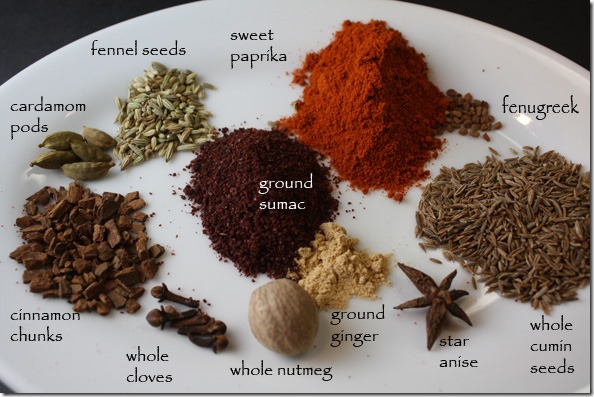
Aren’t the colors beautiful? Seeing this plate reminds me of our trip some years ago to Turkey (in 1997). We visited an underground ancient city in Cappadocia that provided a safe haven for Christians when the Romans were trying to arrest and kill them all. The Christians lived and hid there for months, some for years. There was even a morgue that could be sealed up with a stone (because of the smell, I suppose) because no one could go above ground during that time. Considering this was about 2000 years ago, they had a very sophisticated ventilation system too, so they wouldn’t be found from any little twists of smoke emanating through the rocks hiding the entrance at ground level. In one of the subterranean rooms was a kitchen and a big stone sat right in the middle of this room – the top was flat with a myriad of little 2-4 inch round indentations. It was their kitchen spice cabinet, so to speak. When the underground caverns were discovered centuries later, there were still
 remnants of the herbs and spices in the little cups. At left you can see an example of one (from tryanythingonce blog). Those cups would have held all of the spices you see on the plate above. At right is a photo from the underground caverns (from the vagablond.com). The cavern we visited went down something like 8 stories below ground. It was an ever-winding spiral, down, down, down. Only the top 3 “floors” closest to the surface were open to the public and some of the connecting tunnels were very narrow and low. My DH, who is tall, got stuck in one of them as he bent over trying to move forward, and had to be pushed slightly from behind to get through the passage. Scary for him, as he gets claustrophobic. The picture here shows very wide and tall tunnels. Not so in the one we visited!
remnants of the herbs and spices in the little cups. At left you can see an example of one (from tryanythingonce blog). Those cups would have held all of the spices you see on the plate above. At right is a photo from the underground caverns (from the vagablond.com). The cavern we visited went down something like 8 stories below ground. It was an ever-winding spiral, down, down, down. Only the top 3 “floors” closest to the surface were open to the public and some of the connecting tunnels were very narrow and low. My DH, who is tall, got stuck in one of them as he bent over trying to move forward, and had to be pushed slightly from behind to get through the passage. Scary for him, as he gets claustrophobic. The picture here shows very wide and tall tunnels. Not so in the one we visited!
Anyway, back to this lamb. . . all those spices were toasted and ground up in my spice grinder. If you happen to look at the plate and wonder about the cinnamon – it’s from Penzey’s. They sell it in chunks like that – you can easily use a cinnamon stick – I just happened to have the chunks in my pantry. So the spices were combined with some peanut oil, salt, fresh ginger, garlic, cilantro and lemon juice. I spread it all over the outside of the lamb, puncturing numerous slits in the meat and pushing the mixture into them as well. Into a large plastic bag it went and refrigerated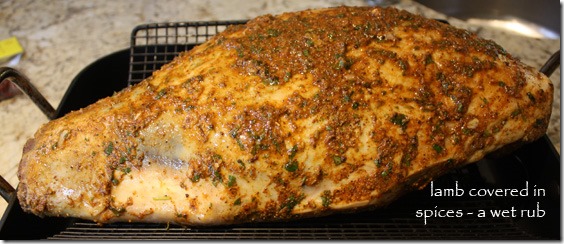
overnight. Most of the marinade stuck well to the lamb, so once it went into a baking pan (on a rack, my turkey roaster actually) it was easy to go right into the oven. The lamb was roasted at a low temp for about 5 hours (part of the time covered with foil). I allowed a little extra time because the lamb leg was bigger than the recipe indicated. The meat wasn’t falling off the bone, really, as some commenters mentioned on other sites where I found the recipe online, but it was quite tender.
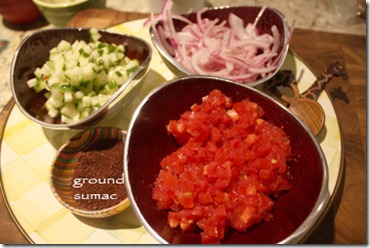 Traditionally this dish is served in either pita bread or some kind of soft foldable flatbread with condiments like chopped tomato, chopped cucumber, onions and definitely some sumac to sprinkle on top. I did the same.
Traditionally this dish is served in either pita bread or some kind of soft foldable flatbread with condiments like chopped tomato, chopped cucumber, onions and definitely some sumac to sprinkle on top. I did the same.
We had fresh sangak bread on hand and I tore it up into hand-sized portions and placed the slices of lamb on the bread. The tray was passed at the table for people to add condiments of their choice. The recipe also mentioned a spread to put on the bread or pita – a mixture of canned tomatoes, harissa, tomato paste, olive oil, salt and pepper. So I spread some of that on each piece of sangak bread as it was served. The harissa added some heat – everyone noticed that. I liked it, actually. The only thing missing in my book was some fresh Greek yogurt to dab on the hand-sandwich. The recipe didn’t indicate it, so I didn’t put it out, but I think it would have been a nice addition.
What’s GOOD: loved the spices in this – warm and cozy. The lamb was not difficult, but was a bit time consuming and I needed to be near the oven periodically over the 5 hours to keep water in the pan below the meat (so it wouldn’t dry out). It made a gorgeous presentation. Meat was well done, obviously. Not dry, though and was still relatively tender. Made a very spectacular centerpiece of a meal.
What’s NOT: it’s a fair amount of work, as I mentioned above. If you have an Alligator 11-1/4-Inch Dicer with Collector, it’s quick work to make the condiments you see above. If you don’t own all the spices already, it could be a bit expensive to buy them all.
printer-friendly CutePDF
MasterCook 5+ file and MasterCook 14 file
* Exported from MasterCook *
Lamb Shawarma
Recipe By: From Jerusalem: A Cookbook, by Ottolenghi & Tamimi
Serving Size: 8
2 teaspoons black peppercorns
5 whole cloves
1/2 teaspoon cardamom pods
1/4 teaspoon fenugreek seeds
1 teaspoon fennel seeds
1 tablespoon cumin seeds
1 whole star anise
1/2 cinnamon stick
1/2 whole nutmeg
1/4 teaspoon ground ginger
1 tablespoon sweet paprika
1 tablespoon sumac
2 1/2 teaspoons Maldon salt — or regular salt
1 ounce fresh ginger — grated
3 cloves garlic — crushed
2/3 cup cilantro — chopped stems and leaves
1/4 cup fresh lemon juice
1/2 cup peanut oil
5 1/2 pounds leg of lamb — bone-in (5.5 to 6.5)
1-2 cups of water added to the roasting pan to keep the lamb moist
CONDIMENTS:
2/3 cup chopped tomatoes
2/3 cup chopped cucumber
1/2 cup sliced onions
1 1/2 tablespoons sumac
Lemon wedges to squeeze over the sandwiches
PASTE FOR THE FLATBREAD:
2/3 cup canned tomatoes — drained, chopped
2 teaspoons harissa
4 teaspoons tomato paste
1 tablespoon olive oil
Salt and pepper to taste
Pita pockets or thin soft flatbread for serving
1. Put the first 8 ingredients in a cast-iron pan and dry-roast on medium-high heat for a minute or two, until the spices begin to pop and release their aromas. Take care not to burn them. Add the nutmeg, ginger, and paprika, toss for a few more seconds, just to heat them, then transfer to a spice grinder. Process the spices to a uniform powder. Transfer to a medium bowl and stir in all the remaining ingredients, apart from the lamb.
2. Use a small sharp knife to score the leg of lamb in a few places, making 2/3-inch-deep slits through the fat and meat to allow the marinade to seep in. Place in a large roasting tin and rub the marinade all over the lamb; use your hands to massage the meat well. Cover the tin with foil and leave aside for at least a couple of hours or, preferably, chill overnight.
3. Preheat the oven to 325°F. Put the lamb in the oven with its fatty side facing up and roast for a total of about 41/2 hours, until the meat is completely tender. After 30 minutes of roasting add about a cup of boiling water to the pan and use this liquid to baste the meat every hour or so. Add more water, as needed, making sure there is always a little in the bottom of the pan. For the last 3 hours, cover the lamb with foil to prevent the spices from burning.
4. Once done, remove the lamb from the oven and let rest for 10 minutes before carving and serving.
– – – – – – – – – – – – – – – – – – –
Per Serving: 756 Calories; 59g Fat (69.9% calories from fat); 46g Protein; 11g Carbohydrate; 4g Dietary Fiber; 170mg Cholesterol; 856mg Sodium.



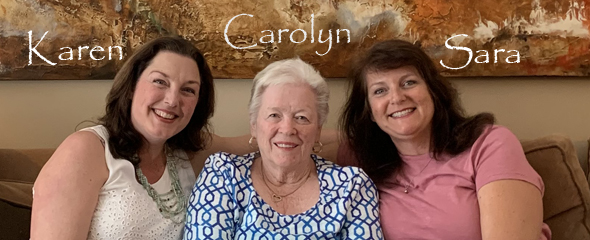
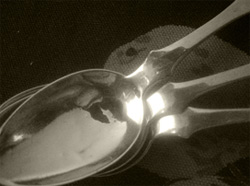
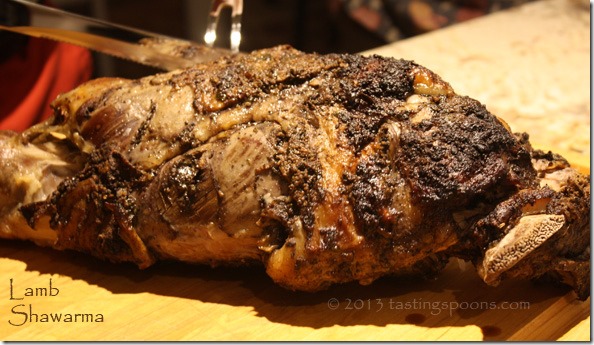

Leave a Comment!